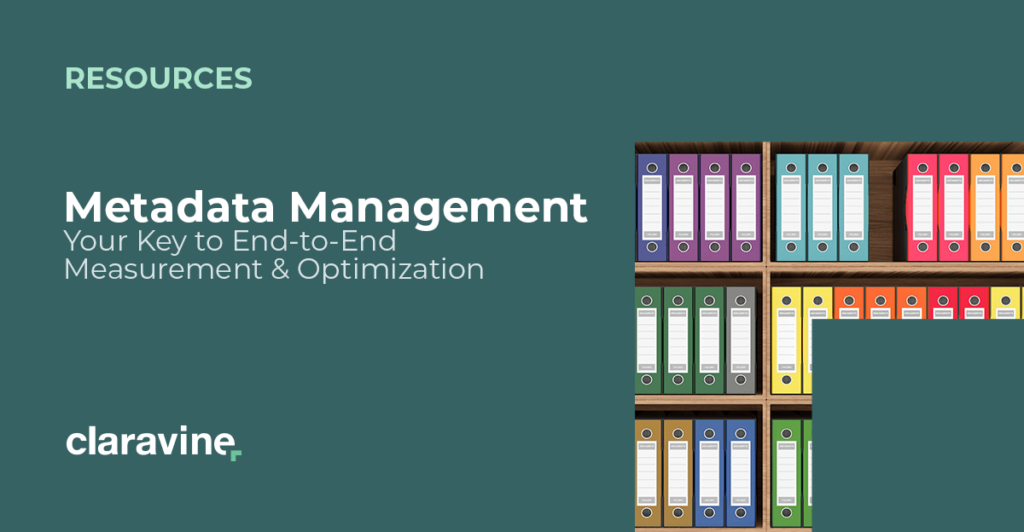Using Cohort Marketing & Measurement in Your Privacy-Friendly Strategy

Cohorts in marketing, measurement, and analytics aren’t new. But in the age of privacy-friendly marketing, they’re getting a lot more attention.
Why?
Because cohort analysis enables marketers to group users together based not only on demographics, but shared events, interests, and behaviors — without compromising Personal Identifiable Information (PII).
According to Claravine’s study on the shift to first party data, 83% of advertisers believe they will be more reliant on first party data, and 81% are shifting from device-level focus to group-level marketing, which could include cohort marketing.
In this post, you’ll learn what cohort marketing is and isn’t, why it’s particularly relevant in a privacy-friendly climate, and how metadata management informs a cohort marketing strategy.
Get Started with Cohort Marketing
Table of Contents
What is a Cohort… and Cohort Marketing?
In marketing, a cohort is a group that is statistically likely to share defined characteristics, such as demographic tendencies, an experience, or behavior. A cohort could be a group of users of a certain age, who live in a particular region, who all downloaded a mobile app within a certain time period.
Or, marketers might build a cohort of folks who attended a concert or lived through a certain experience. You can get pretty granular — if you have the right consumer data and tools.
Cohort analysis (which informs cohort marketing) is a type of customer behavioral analysis based on audience cohorts. Statisticians, scientists, researchers, and yes, marketers use cohort analysis to understand a group’s behavior over time.
Google Analytics offers cohort analysis reporting to help companies improve customer understanding and assess and improve websites and marketing campaigns. For example, if you observe a cohort tends to disengage with your website after a certain time period, you can make a pointed effort (i.e. run a remarketing campaign or offer a promo code) to keep them engaged at that time period to improve retention and drive revenue.
Marketers should be considering cohort analysis as a cross-media tool for audience cohort segmentation, targeting, analysis, A/B testing, and measurement. Marketers can also conduct cohort analysis on their own, but they can’t build effective cohorts without first-party data and a solid data framework. Cohort marketing is yet another measurement strategy that depends on metadata management, an organization’s defined approach to defining, storing, and activating metadata.
What Isn’t a Cohort?
Cohorts are different from a straight-forward demographic grouping. In fact, creating cohorts is a way to further segment a group that shares certain traits.
For example, if you take an audience that shares demographic tendencies and group them into two cohorts — one that was exposed to your marketing campaign, and one that was not — you can compare the cohorts’ behavior over time to assess ad performance.
Cohorts are a grouping of aggregated data, rather than a 1:1 marketing tactic based on user-level IDs. So, marketers can use cohort analysis without violating user privacy or data regulations but still satisfy their need for segmented, personalized customer experiences that improve revenue and retention.
Cohorts Come to Life in the Metadata
A cohort is a grouping of data, in aggregate form (repeating that for staying power). That data should roll up into a marketing taxonomy, or a defined framework for grouping and organizing the entirety of an enterprise’s data. Taxonomies ensure marketers describe assets and use metadata tags consistently.
You can think of a taxonomy as a Dewey Decimal System for data/metadatata — a standard process for organizing information.
While every company should have a data governance framework, creating one is particularly important for enterprises since multiple business units, regions, teams, and marketing partners create and leverage data. Large companies also use multiple SaaS platforms, which can lead to data sprawl, so taking a unified data approach makes sure your data is an asset, as opposed to an overwhelming chore.
Metadata is a subset of data that provides context to information, explaining, for example, who created an asset (author), where it is stored (file location), when it was created (file date), and how it was formatted (file format).
Metadata also includes company-specific information, such as keywords, or even an emotional tag to define the intended vibe of a marketing campaign, i.e. “funny” or “nostalgic.” It is important to have a uniform approach to inputting this data and naming files so teams can share data and assets effectively and aggregate data more easily.
A marketing data standards tool enables users to automate parts of this process and define and manage the relationships between metadata across myriad channels and teams.

Building Cohorts You Can Actually Trust (and Measure!)
Creating data standards increases an enterprise’s trust in your marketing conclusions — something many teams are lacking.
According to recent research, 54% of B2B marketers are not confident or only somewhat confident in their organization’s data cleaning process, and 56% aren’t confident their organization can properly segment their database to create an effective pipeline for sales. A Nielsen survey found that less than one in five marketers are confident they can accurately measure marketing ROI, or that they have the technology tools they need to do so.
Certainly, the marketing measurement challenge isn’t getting any easier with the phase-out of the third-party cookie. Claravine conducted research to understand how B2C brands plan to shift strategies once device-level tracking is no more; 38% are not sure if they have the technology they need to categorize data with the metadata that’s crucial to be successful in this endeavor.
Cohorts and Clean Rooms
Adopting a system-wide approach to metadata management is also important for the growing number of marketers that are using walled-garden data clean rooms.
Clean rooms are software platforms that enable Facebook, Google, and Amazon to encrypt and hash PII so they can share customer data in a safe and secure (clean) environment that allows analysis and measurement (room). Marketers can add and match their first-party data, which is also encrypted, to evaluate campaign performance.
To achieve a more holistic picture of an audience, a company may wish to create a cohort of users across channels, including data clean rooms. Establishing a data framework that includes metadata management will ensure teams are aligned on naming conventions and marketing objectives and allow teams to interconnect data and marketing tactics.
Of course, a data standards platform will serve as a centralized home for your data — a single source of truth — and make it much simpler to achieve end-to-end measurement across cohorts and in-and-out of clean rooms.
Cohorts Will Make You Forget About Cookies
At the risk of ruffling a few feathers: cookies led to lazy marketing.
Third-party cookies were never intended to be used as the marketing supertool.
As an industry, we all knew these little behavioral trackers had problems, even before GDPR and the consumer privacy moment. They were incomplete pictures that were often treated as whole. They were negatively impacting the user experience. And tracking was getting out of control.
Plus, few marketers had strategies for deriving value from all the extra data points they were collecting. The juice was not worth the squeeze.
Cohort marketing is different. Marketers can draw meaningful conclusions, without infringing on consumer privacy.
Cohort analysis is new territory for some marketers. They haven’t needed cohorts, because they had personal identifiers. While it will take some getting used to, as well as new strategies and tools, there is no need to lament the loss of user-level info.
What we give up in precision, we gain in breadth. In other words, you can still draw important conclusions about your campaigns, content, and websites using cohort analysis, as opposed to analyzing cookies.
The departure of third-party cookies will continue to inspire wider adoption of approaches like this one — privacy-friendly tactics that can be used to create holistic, multi-channel measurement strategies. Steps one and two are creating and enforcing a taxonomy by standardizing and automating data collection and management processes, and taking a uniform approach to the first-party data tactics you will need to succeed.







